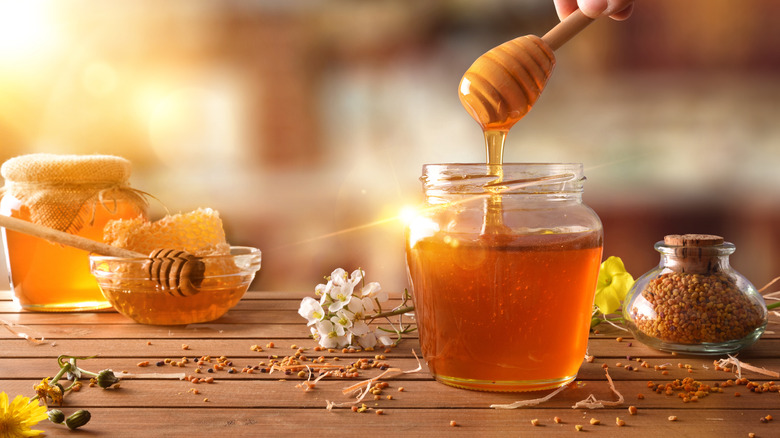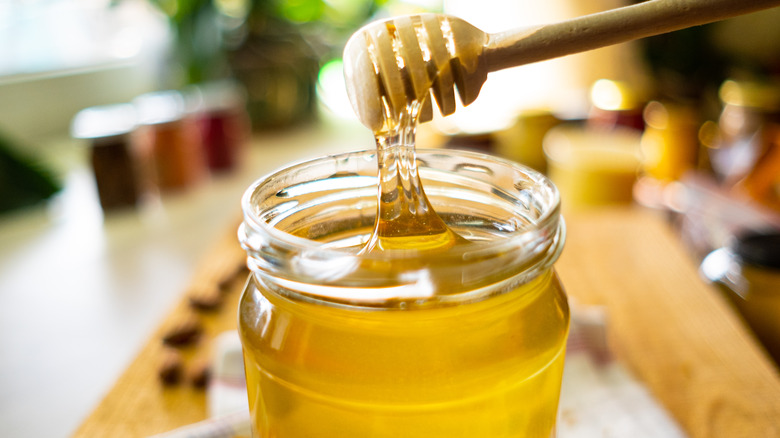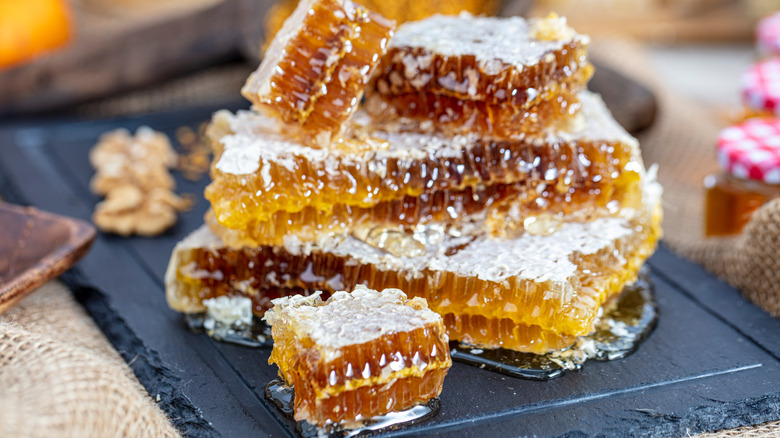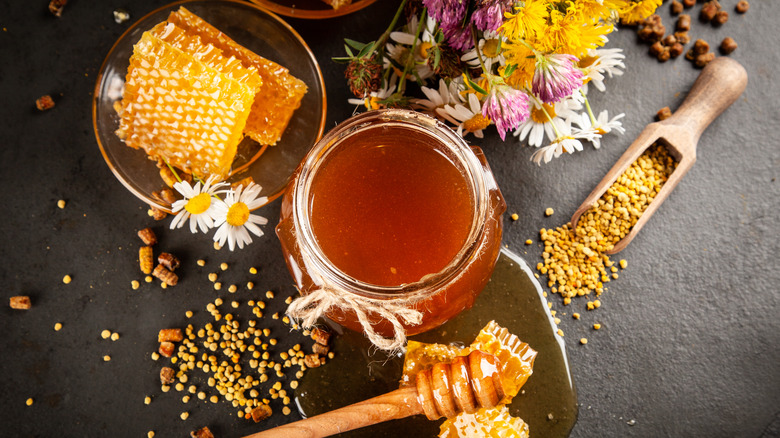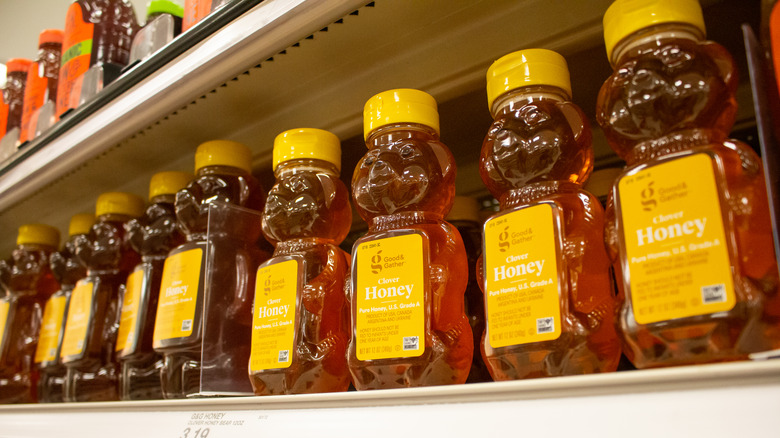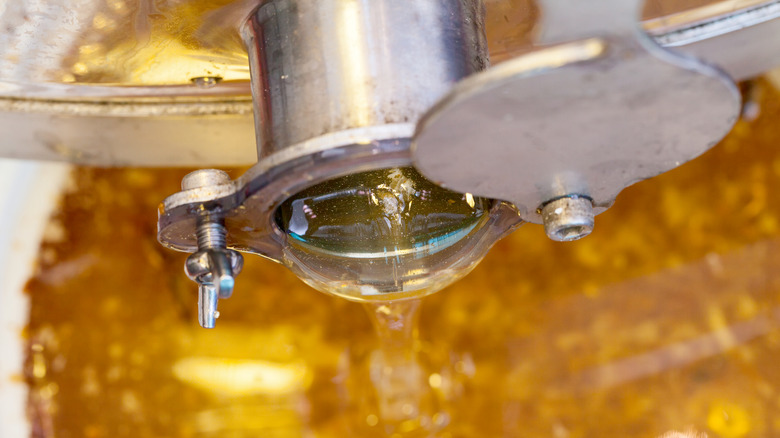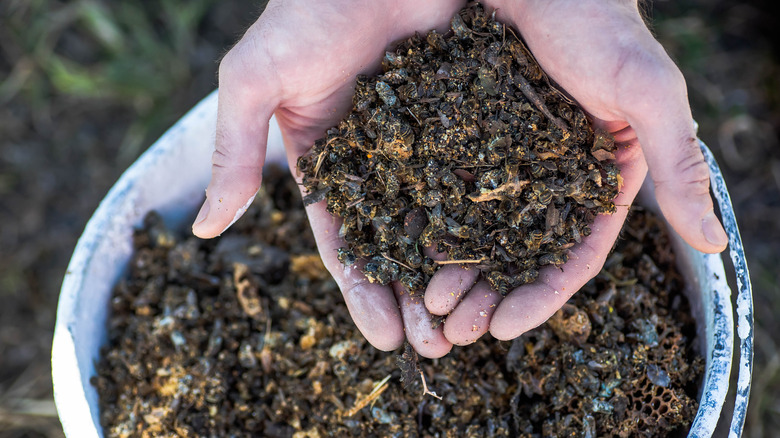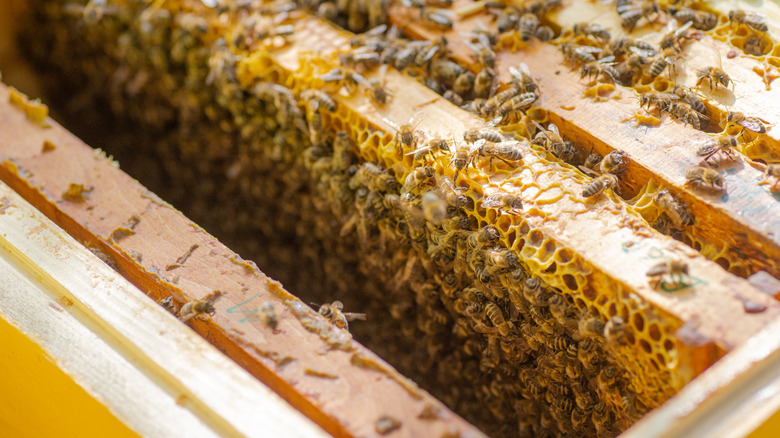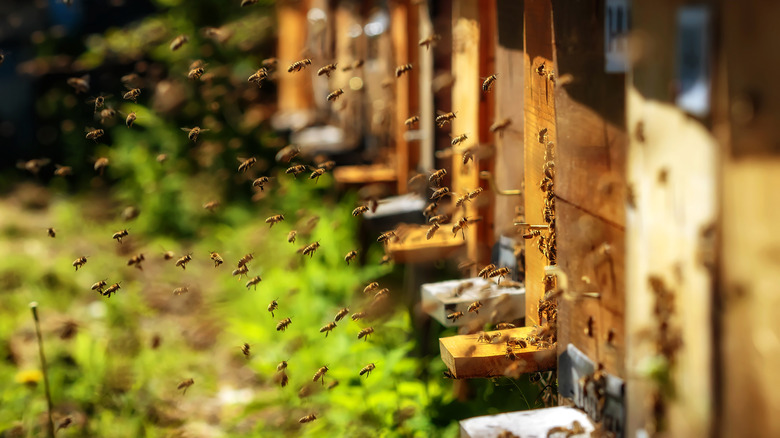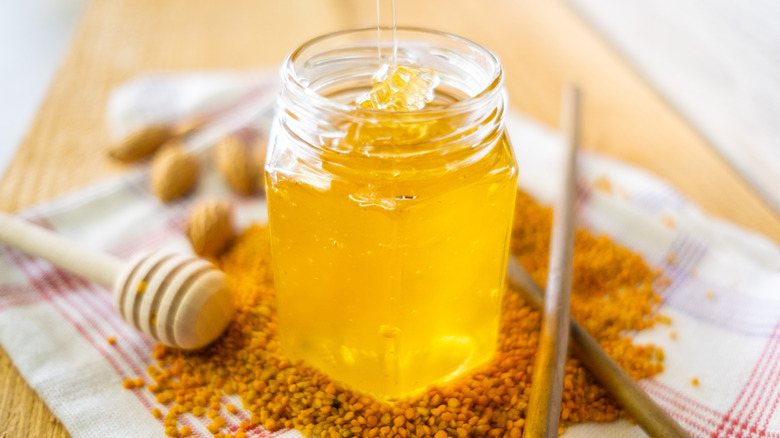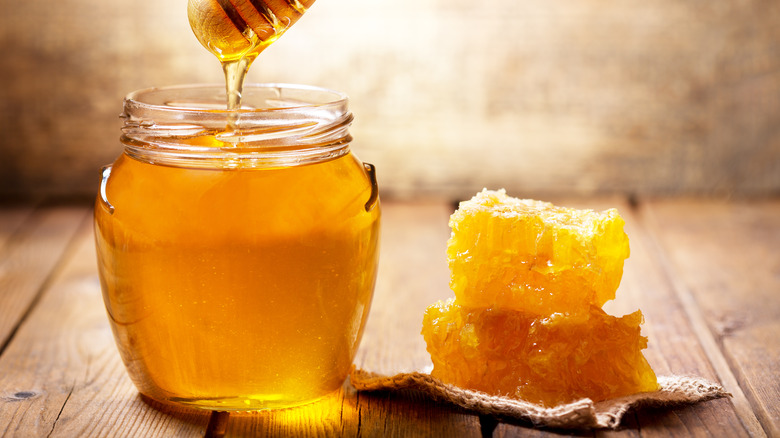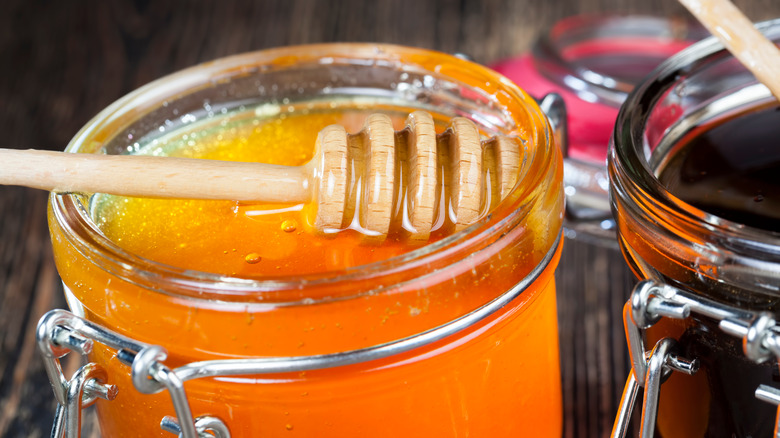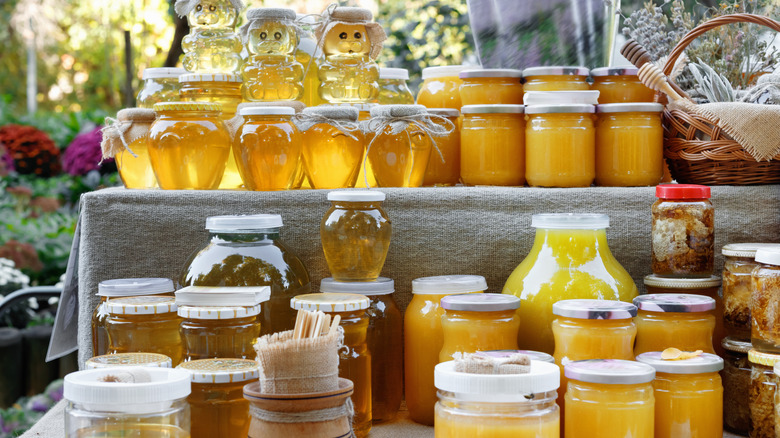The Shady Side Of Honey
For its fans, honey is considered a superfood if there ever was one. The sweet, golden nectar comes straight from mother earth — via honey bees, of course — and is well-known for its nutritious and tasty properties. Chances are, it was working its magic in your last cup of green tea. Not to mention, honey is widely used for cooking and baking purposes across cuisines. Honey can do it all.
But the truth of the matter is that not everything about honey is quite as sweet as it seems. There's a lot more to this nectar than meets the eye, including the full and unvarnished picture of honey's positive and negative health effects. Furthermore, there's a lot the public doesn't seemingly understand about the impact of honey production and harvesting on the environment and the bees themselves, and why it's so important to buy ethically produced honey whenever possible. So, in the interest of getting a more complete sense of this unique food's place in the modern world, this is the shady side of honey.
Honey is full of sugar and calories
The first thing to know about honey is that it is full of sugar. The natural syrupy nectar is often used as an alternative to refined sugar, but it's important to know that honey isn't necessarily as healthy as it may seem, even though it can be found in less processed forms compared to sweeteners like white sugar. Per Verywell Fit, honey consists mostly of glucose and fructose, which at a chemical level are really another set of simple sugars, like the sucrose in table sugar.
So while it's true that honey is high in antioxidants and is widely believed to have other health benefits, honey is also full of sugar and calories. Therefore honey can contribute to a range of negative health effects related to excess sugar consumption, which Healthline says can lead to things like heart disease, obesity, liver issues, inflammation, and problems with insulin.
Now, don't freak out if you're only consuming a little bit of honey at a time. It's clear that, for most people, a daily teaspoon of honey in your tea or oatmeal isn't going to hurt you. But according to registered dietician Jenny Friedman, who spoke to Time, "we'd have to eat a lot of honey," to really see the full nutritional benefits that are so often touted by some sources. "[U]nfortunately, consuming a lot of honey means consuming a lot of calories."
Eating too much honey can cause weight gain
One of the specific health risks that can be associated with eating a lot of honey is weight gain. Healthline says honey contains about 64 calories in a single tablespoon. That may not be much by itself, but that can add up over time for dedicated honey consumers, and also depending on what the rest of your diet looks like. And because your body digests the sugars in honey so quickly, it can cause your blood sugar to spike and crash, making you feel hungrier and therefore causing you to eat or snack even more.
It's also important to note that honey consumption can carry some risk for people with diabetes. That's because of the way honey reacts with insulin, which can then impact blood sugar (via Verywell Health). The bottom line, as Healthline points out, is that a lot of research has linked added sugar with increased risk for weight gain and all of the side effects of being overweight or obese.
Honey can trigger severe allergic reactions
Bees are very industrious little creatures. They wander their way through a myriad of plants and vegetation, picking up a range of pollens and other particles before returning to the hive and producing the nectar we will consume as honey. Therefore, a lot of what they interact with will make its way into your honey. Depending on what, exactly, those bees visited, this can be bad news for people with allergies. Despite the fact that honey has long been thought to help treat or prevent seasonal allergies, it turns out that the pollen in honey can actually cause or worsen allergic reactions in highly sensitive people, according to allergist Lakiea Wright (via Eat This, Not That).
Healthline says honey-induced allergies often present themselves in the form of sneezing, runny nose, watery eyes, rashes or hives, an itchy throat, or swelling. Usually, these allergies can be treated with over-the-counter antihistamines but sometimes further medical treatment is required for anyone having a more intense allergic reaction. The Mayo Clinic also warns that, in rare cases, some pollen allergies can be severe or fatal.
Many brands of honey are highly processed
In recent years, you might notice more and more jars of "raw" honey on the grocery store shelves. This style of honey is becoming increasingly popular, and, according to Bee Culture, the distinction helps shine a light on another shady side of honey. First, the difference between raw and regular honey comes down to how the honey is processed before it gets to the consumer. Raw honey is honey that is simply not pasteurized, filtered, or commercially processed in any way (via Healthline). It's basically as close to the beehive as you can get without crawling inside yourself (which we would not recommend, anyway, both for your sake and that of the bees). In other words, raw honey is harvested, strained, and then poured right into a jar.
On the other hand, most honey brands that we are familiar with has undergone several steps of processing before it makes its way to our kitchen. These include a pasteurization heat treatment and many levels of filtration, among other steps. These treatments can strip honey of all the nutritional goodies that we hope to get from it, including the pollen which gives honey most of its antibiotic and antioxidant properties (via Well + Good). And what's worse is that honey processing often involves adding extra sweeteners or fillers to cut costs, which may be easier on your wallet, but only makes the honey more unhealthy (via Healthline).
Pasteurized honey can be stripped of many nutrients
One of the most common processes that most commercial honey goes through before it makes it to store shelves is a heat treatment known as pasteurization. The high temperatures used during the process kill off any yeast in the honey, making it more shelf-stable, and helps give it the smooth and clear texture we're used to. However, all that heat also tends to kill off the nutritional properties in honey along the way, including enzymes, vitamins, minerals, and proteins (via Country Bee Honey Farm and Livestrong).
Another standard process used to treat honey is filtration. This process helps remove tons of tiny particles, air bubbles, and other impurities from honey before it's consumed (via IFT). And while that may sound like a good thing, the filtration process also tends to stip honey of all its natural pollen — known as honey laundering — which is what actually gives honey most of its antibiotic and antioxidant properties (via Well + Good). Bottom line, if you're going to consume honey for the health benefits, you're like better off opting for raw honey which will still contain all of its nutritional properties.
Harvesting honey can be harmful to bees
It's not just our own health that needs to be considered when it comes to honey consumption. We need bees to make honey, consider that they are our only source for this sweet substance we love so much. So it's important to realize that a lot of our practices for producing and harvesting honey for human consumption can be really harmful to the creatures we need the most — the bees themselves.
While honey is a natural substance produced in the wild, human demand for it has seriously knocked nature off course. As Fast Company points out, we extract way more honey than bees would make on their own in a natural environment. This means that they are often overworked and underappreciated in the commercial honey farming process.
For starters, harvesting honey for humans means there's less for the bees to consume. Bees create honey from nectar, using their own enzymes, specifically so they can eat it (via PETA). This means that they need it as their primary source of fuel and nutrition. Bee farmers usually give the bees a sugary substitute to make up for the loss, but it doesn't contain all the same benefits as the honey that they produce naturally (via The Ecologist). This can potentially leave the bees exhausted, malnourished, and more vulnerable to disease (via Fast Company).
Increased demand for honey has led to cruel factory farming practices
Because humans want so much more honey than bees can naturally produce, bee farmers have adopted a range of practices to ramp up production as cheaply as possible, including forcing bees to live in crowded, unnatural conditions, forcing them to endure stressful bouts of transportation, and overworking them.
One common procedure involves clipping the wings of the queen bee, which helps to prevent swarming. Workers bees always follow their queen, so if she can't leave the hive, then the bees will stick around too and make even more honey (via PETA). Another practice designed to increase productivity is selective bee breeding. This kind of genetic manipulation increases hive productivity, but it can also decrease diversity and can adversely affect the whole species in the long run (via Greenopedia).
Furthermore, many bees are expected to do double duty, working in a hive to produce honey and then being shipped off to other farms to pollinate plants and crops. And after the end of a honey-producing season, another practice often used on bees is known as culling. That's a practice that involves basically killing off an entire hive because it's cheaper than keeping the bees alive through the winter months (via The Ecologist).
It's also worth noting that this is all happening as climate change — much of it created or exacerbated by human practices — is also contributing to bee population decline through widespread habitat loss (via Smithsonian Magazine).
Too many honey bees can have dire consequences for the environment
As far as insects go, honeybees are some of the least offensive ones out there. Sure, they might sting you from time to time, but they aren't as aggressive or venomous as many other insect species. Some would even say that bees are downright cute. And with our love for honey not fading anytime soon, a hefty honeybee population is kind of necessary. However, too much of even a cute thing is never all that good. And unfortunately, misinformation and a misguided effort to "save the bees" has led to a disproportionate honeybee population (via Sierra Club).
Honeybees are actually a non-native bee species that was imported to the Americas which is actually the least at risk of all bee populations (via NPR). However, because they make honey and they make for an adorable cartoon, bee conservation efforts have been disproportionately directed their way.
But the real problem with overinflating honey bee populations, through factory farming and hobby bee-keeping, is that they then compete with native bee populations. This is a pretty big deal because native bee populations are the ones actually facing the biggest threats of extinction. Just as important, they are the bees we need so badly to help maintain balance and diversity in our natural ecosystems and our global agricultural systems (via Scientific American). So, all those cute honey bees are arguably taking attention away from the bee species that need the most help right now.
Raw honey can contain pollutants
The sad truth is that, when you eat honey, you could well be ingesting a toxin of some sort, according to The Scientific World Journal. For one, raw honey, which typically hasn't been filtered in any way, can contain a range of environmental pollutants including lead, cadmium, and arsenic, per Livestrong. But even more cringe-worthy is the fact that honey is actually full of pesticides. In 2017, The Guardian reported on a new study at the time which claimed that about three-quarters of all the honey in the world is contaminated with pesticides. The study, published in Science, found that North America had the highest rate of contamination at a staggering 86%.
Health experts say the levels of pesticides and pollutants in most honey are so low that it's still safe for most humans to consume. But it's worth noting that this is not the same case for bees. Pesticides are a major factor in the decline of the global bee population, as reported by The Verge, as chemicals in most common pesticides have been shown to impact bee's brains. This can cause them to get lost while pollinating or increase their susceptibility to potentially devastating diseases.
And some of those environmental pollutants can stick around for a seriously long time. In 2021, Science reported on research that found trace amounts of radioactive residue from nuclear bomb tests in the 1950s and '60s showing up in honey samples in the U.S.
Honey poisoning is a thing
While it's admittedly very rare, it is possible that eating honey can make you sick. That all depends on exactly what the honey bees came into contact with when they were moving through their local environment.
Honey naturally contains small amounts of neurotoxins calls grayanotoxins (via Healthline). Bees can pick them up from local plants and flowers (rhododendron and azaleas are known carriers), making the exact amount of toxin in a given sample of honey hard to measure. When you eat raw honey, you increase your risk of consuming these grayanotoxins and getting honey poisoning, also known as Mad Honey Disease, per the journal Cardiovascular Toxicology. The symptoms can range from dizziness and nausea to vomiting and even problems with heart rhythm and blood pressure.
It is worth noting that honey poisoning isn't very common, and your risk of getting it is pretty low unless you're consuming Winnie the Pooh levels of honey on a regular basis. And the cases that do turn up are rarely, if ever, serious or fatal, according to Science Direct.
Honey can cause botulism in infants
While most adults can safely eat honey without any serious risks, health experts warn explicitly that honey should not be given to infants, ever. That's all due to the risk of exposure to botulism. Honey naturally contains spores of bacteria called C. botulinum which can be found widely in nature, usually in soil and untreated bodies of water (via World Health Organization). And, as Livestrong notes, botulism spores can be found in both raw and treated honey.
Mature immune systems develop enough of a resistance to botulism that the limited exposure to honey is usually harmless. But babies with their brand new immune systems are particularly vulnerable to the bacteria. In fact, it's estimated that about 65% of botulism cases occur in infants less than 12 months old (via Healthline).
The Mayo Clinic warns that if C. botulinum gets into an infant's gastrointestinal system, the bacteria will multiply rapidly and produce a dangerous toxin that causes severe gastrointestinal issues and can be life-threatening. The safest preventative measure is to simply keep the sweet stuff away from babies for their first year. And remember that some products containing honey, like graham crackers, can still cause the same issues, so steer clear of those, too.
Consuming a lot of honey might get you in trouble with the dentist
We've all heard the dentist remind us to limit our intake of sugary treats and candy for the sake of our teeth. If you hadn't guessed yet, the same is true for honey. The sweet substance is basically all sugar, after all, and therefore can lead to some serious issues at the dentist. Of course, if you limit your intake and also remember to brush and floss on the regular, you should be just fine.
But dentists warn that excessive honey consumption can lead to tooth decay, cavities, and gum disease. As Watertower Dental in Chicago explains, bacteria in your mouth feeds on sugar. More sugar means more bacteria. As more bacterial plaque forms, it creates acid that can eat away at your teeth. Honey's acidic pH balance may also help to aid in damaging tooth enamel, according to Buzz About Bees, though you would have to be consuming large amounts and rarely brushing your teeth to get the worst effect.
